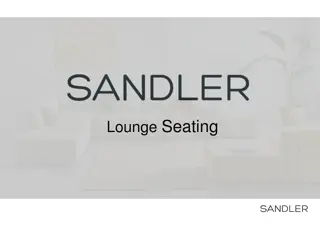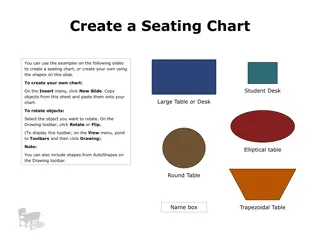Understanding Wheelchairs and Seating Essentials
Explore the basics of wheelchairs, from their parts to types, including ultralight frames. Learn why ultralight wheelchairs are beneficial and how to preserve shoulder health while using a wheelchair. Discover the features of armrests and their importance in wheelchair design.
Download Presentation

Please find below an Image/Link to download the presentation.
The content on the website is provided AS IS for your information and personal use only. It may not be sold, licensed, or shared on other websites without obtaining consent from the author. Download presentation by click this link. If you encounter any issues during the download, it is possible that the publisher has removed the file from their server.
E N D
Presentation Transcript
Introduction to Wheelchairs and Seating Spinal Cord Medicine Education
Basic Parts of a Wheelchair A frame or a power base A seat and back support Cushion Armrests Leg rests & footplates Wheels/Tires Brakes Motor and electronics Anti-tippers Other features
Types of Manual Wheelchairs Standard temporary use ONLY Few sizes, no adjustability Lightweight for temporary use Few sizes, no adjustability of axle, no support for posture Ultra Lightweight Adjustable axle position Lightest weight possible Allow custom fit & posture support Recommended for person with a spinal cord injury
Two Types of Ultralight Frames Folding or Cross Frame Rigid or Z Frame
Why an Ultralight? Made to your body measurements Weight is less than of a standard wheelchair Axle position is moveable Better position for preventing injury Easier to push and less effort Moving requires fewer pushes Very strong lasts 3 times longer than standard Designed for all day, every day use
PVA Guide: Shoulder Preservation 10 years of research shows postpone or avoid repetitive strain injury to shoulder: Best alignment for shoulder, wrist & elbows Lightest weight wheelchair offer less resistance and require less force to push Fewer push strokes Also use good transfer techniques to avoid straining shoulder ligaments and tendons
Features: Armrests Tubular, swing away Rotate to the rear Decrease chair width Easy access to pushrims T-shaped, quick release Full or desk length Height adjustable Flip back or easy remove for transfers Built in side guards
Features: Armrests No Armrests With good pelvic and trunk support, not really needed Full access to the wheels Use clothing guards to position cushion and prevent shearing from wheels John Hockenberry, August 2001 Cover
Features: Leg Rests Swing Away or Removable Swing in or swing out Can get out of way for transfers Drop-in vs. pegs Offer varying amounts of knee angle Elevating Not effective except when there is a knee problem Heavy and hard to manage
Features: Leg Rests Stationary or fixed Preferred to shorten wheel base & control leg position May or may not interfere with transfers Complicate stand pivot transfers Tapered or straight Controls foot position Makes it easier to maneuver in small spaces
Features: Foam Cusions Foam Inexpensive Wears out quickly & needs to be replaced often Amount of contour can affect pressure distribution Can shape as desired and make use of various densities Good transfer surface depending on cover Doesn t deflate or leak Holds moisture & heat next to skin Harder to clean
Features: Gel/Viscous Fluid Cushions Gel or Viscous Fluid Gel shapes to body for good pressure distribution and immersion of bony prominences Deeper gel under sitting bones Relatively easy to clean Gel can migrate causing cushion to bottom out Cools the skin at first but can hold heat after sitting for a while Gel can freeze in cold or hold heat Heavier than foam Can be combined with foam cushion Gel clumps or hardens with age & needs to be replaced
Features: Air Cushions Air ROHO & Others Interconnected air bladders allow cushion to match shape of buttocks Good air circulation and evaporation Can be submerged in water to clean Proper inflation is key to good pressure distribution. to 1 clearance Will leak if punctured or hot ashes are dropped Less stability Transfers are more difficult
Features: Orthotic Cushions Orthotic Customized to the individual to prevent or correct collapse Excellent stability and control of pelvic position Off-loads pressure on ITs and moves it to tolerant areas. Excellent air circulation and evaporation Easy to clean Transfers can require more strength and pelvis needs to stay in position. Doesn t work with standing wheelchairs and only limited recline
Features: Back Supports Sling Standard Encourages slumping and kyphotic posture Adjustable tension Changes support to improve seated posture Easily adjusted Back rest height Tall increases support but limits arm and trunk movement Lower better for arm and trunk movement. Does not interfere with scapular movement.
Features: Back Support/Rigid Contoured Multiple sizes & shapes Quick release or fixed hardware Improved support for the lumbar curve and can have lateral support Encourages upright posture Doesn t interfere with push stroke if low enough A firm surface to push against when propelling
Features: Wheels & Tires Polyurethane Solid treaded tires Durable and low maintenance Tends to slide on hard flooring Pneumatic or Air filled Softer ride, less shock Treaded for increased traction Can get a flat, replace or repair like a bike tire Also high pressure, high performance Flat-free or foam filled inserts Eliminates flats and maintenance Harder ride, heavier to push Heavy, more rolling resistance
Features: Push Rims Standard aluminum Requires good hand function Smooth, less burn when braking Coated Rubber coating increases grip Facilitates pushing with palm of hand Coating also increases friction Ergonomic or Natural Fit Ergonomic, designed to fit the thumb and hand grip More surface for pushing
Features: Push Rims Projection Push rims Vertical, oblique or horizontal Various lengths and number per rim Used by quads without hand grip Not recommended, overuse injuries Push Rim Activated Power Assist Wheels Motor & batteries surround the hub Push rim becomes the trigger Force of each push is increased Each quick release wheel weighs 15 to 30 lbs. Variable assistance for ramps, hills or fatigue Expensive ~ $6,000 Add to an ultralight wheelchair
More Wheel Options Quick Release Axles Reduces weight & size for car stowage Change wheels for activity Spokes Less weight Provides shock absorption Less wind resistance Require maintenance Spoke guards can protect fingers Mag Wheels Heavy and considered durable Lower maintenance Protects fingers Also have quick release axles
Pressure Relief Please take this time to pause the presentation and complete pressure relief.
More Wheel Options Essential: Axle Adjustment Forward placement Increase propulsion efficiency Easier wheelies Decreases turning radius But Decreased stability Rearward placement Increased stability Decreased efficiency; harder to push Camber Wheels angle in toward body Wider base of support but increases overall width Quicker, easier turning
More Wheel Options: Wheel Locks Pull-to-lock Handle is out of the way during propulsion Push-to-lock Can use body weight to engage Scissor lock Mounted under the frame Protects thumbs from trauma during propulsion Requires good upper extremity skill because of their placement Brake extensions Slip on and make the brake lever longer and easier to push or reach
More Wheel Options: Casters Solid Foam filled, molded plastic or solid rubber Less maintenance Less rolling resistance Pneumatic Provide shock absorption High maintenance Larger Harder to turn, less responsive Tolerant of community surfaces Usually pneumatic Smaller Easier to turn Requires ability to do a wheelie
Power Wheelchairs: Drive Wheel Placement Front-wheel drive Pulls over obstacles Easy to maneuver Mid-wheel drive Tightest turning radius Excellent for indoors Rear-wheel drive Original drive mode
Power Wheelchairs: Power Seating Power Tilt Power Recline Power Leg Elevator Power Seat Elevator Stander All allow change in body position
Power Wheelchairs: Seating Standard After Market Custom Contoured
Power Wheelchairs: Seating Cushions Use the same kinds as in manual wheelchairs Back supports Some minimal like manual but most offer more support and taller when using powered seating for weight shifts
Power Wheelchairs: Arm Supports Chosen to meet needs for transfers, body support and pressure distribution Standard Flip back Cantilevered T-shape Arm troughs
Power Wheelchairs: Seating Options Head support is needed with power seating options Recline Tilt
Power Wheelchairs: Controls Standard Joystick Right or left side Programmable Can be fine tuned to the user or changed as condition changes Retractable mount Allows pulling up to a table or desk and out of way for transfers.
Power Wheelchairs: Specialty Controls Other ways to control a wheelchair Head Array Sip n Puff Micro Joystick
Manual Vs. Power Light <30 pounds Easy to put in a car/SUV Easy to pull up stairs Heavy people = wide wheelchair Cost -$2000 to $3,000 Easier to maintain and repair Coordinated effort from arm muscles propels the wheelchair Heavy > 200 pounds Needs special transportation: bus, van Needs ramped or level entrances Cost -$5,000-$50,000 Motors, electronics, & actuators need maintenance Independent mobility even with significant paralysis
Why Special Seating? With muscle weakness the skeleton needs external support Sitting with good posture helps to protect the shoulders Without sensation, the buttocks and lower back need relief from excessive pressure Ischial tuberosities Coccyx Sacrum Without good arm or trunk strength, power seating is the only way to get pressure relief.
Best Advice Work with an experienced therapist who knows your body and understands wheelchair features Buy from an ATP certified seating and mobility specialist Ask about their repair department Speak up. Its your ride for the next 5 years UofL Health - Frazier Rehab Institute Wheelchair Seating and Mobility Clinic For an appointment, call: 502-582-7660























